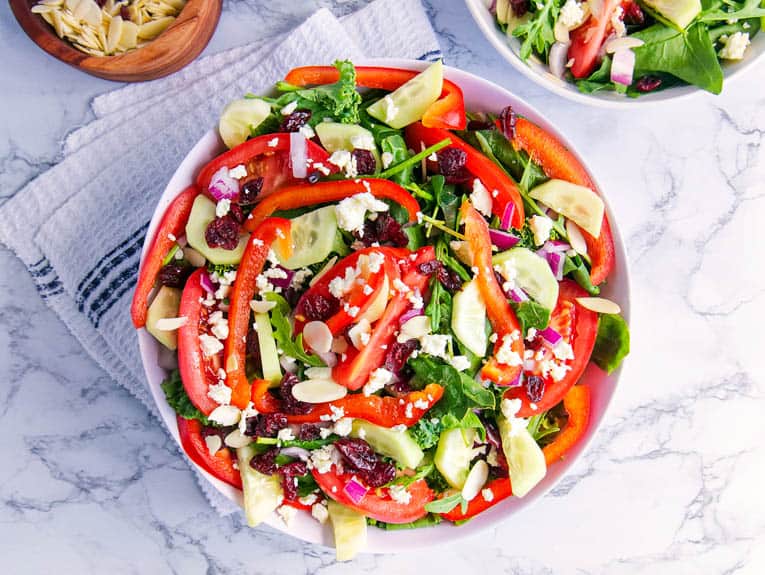10 Tips to Avoiding Mealtime Battles
This post may contain affiliate links. As an Amazon Associate, I earn from qualifying purchases. Please read my disclosure.Let’s face it — most kids, at some point, can show picky eating tendencies. Those tendencies might just be a phase, or they may evolve into picky eating at every meal, all the time. Raising a true picky eater can be such a struggle! Sometimes, despite your best efforts to cook nutritious, varied, and delicious meals, your kids just aren’t interested in trying anything new. It can be so demoralizing to spending time, money, and energy creating a healthy dish that you think your kids will love, only to be told “yuck!” “I don’t want that!” And then the mealtime battles begin — which is one of the least fun parts of parenting.

It’s exhausting to fight about vegetables every mealtime, and the battles can make you feel defeated when your child leaves perfectly good broccoli or carrots untouched on his or her plate. To make it worse – junk food or “treat” meals are always in demand, because honestly, who wouldn’t want pizza or ice cream all the time? Even kids who are typically open-minded will sometimes decide that they simply don’t like a certain food, without any logical explanation. 🤷♀️
It’s only natural to be frustrated. But the problem is, “healthy” doesn’t mean anything to kids, and they have no reason to accept that vegetables or other whole-food-based meals are good for them (or that you’ve worked hard to make them as tasty as possible!)
Luckily, there are some tried and true strategies that will help take the drama out of mealtimes and get your picky eater excited about trying new foods! These are strategies that I’ve implemented in my own kitchen, and in the kitchens of hundreds of families I’ve worked with. But every child and every family is unique. So don’t worry if not all of these ideas fit in with your mealtime routine, or if you have to adapt them to fit your child’s needs. However, I’m confident that even the pickiest of eaters can learn to love trying new foods (and even momentarily forget about mac ‘n’ cheese and ice cream!) with the right encouragement and a few handy tips and tricks.
In addition to implementing these strategies, if you have an extremely picky eater, I also recommend supplementing with a whole food multivitamin that includes 12 organic fruits & veggies as well!

Here are my 10 Tips to Avoiding Mealtime Battles
Tip #1: Use Positive Language, Avoid the “Picky Eater” Label
Before we begin, it’s important to realize that showing picky eating tendencies is pretty much the norm for kids — whether it’s a toddler discovering food for the first time or a 1st grader who wants a “cooler” lunch. All kids can be fickle: a favorite food may suddenly be rejected, or they may decide that they only want to eat one or two very specific things. This is perfectly fine — and it’s better to avoid the label of “picky eater” as much as possible when your child is growing up. If a child hears that he or she is a “picky eater,” they are probably going to accept that as a fact, and will be totally unmotivated to change.
Instead, use language unrelated to food and make it more about values: e.g. “we always try” or “we always include.” These are phrases that can be applied to things outside of food (e.g. trying when something is difficult, or being inclusive when playing with kids) — but can also be applied to food (e.g. we always try at least 2 bites, or we always include all the parts of our meal).
Additionally, children’s tastes are constantly evolving, after all, and if you provide a variety of nutritious options, they will eventually become accustomed to eating varied, healthy meals.
Tip #2: Model Healthy Eating Habits
The first step towards avoiding mealtime battles takes place long before you get to the table. It’s all about what foods you keep in the house. If there are sugary drinks and snacks in the pantry or in the fridge, it will be more difficult for your child to understand that those aren’t part of a healthy meal, or what they should be eating on a regular basis. The best thing you can do is to avoid purchasing unhealthy foods in the first place. This also means being a positive role model when it comes to having a healthy, balanced diet. If your kids see you enjoying the same meal that they are being served for dinner, they will be more likely to eat what’s on their plate. Modeling good eating habits also means making good choices in front of them 90% of the time, whether at home, at a restaurant, or at the grocery store.

Tip #3: Make Grocery Shopping Fun
Getting kids involved in their food is key to avoiding mealtime battles and helping them to be open-minded about what they eat. This can start at the grocery store, where you can show them all sorts of wonderful fruits and vegetables and encourage them not only to pick out their favorites but also to try something new. If they love carrots, why not try butternut squash? If they can’t get enough of apples, how about tomatoes? Try playing games at the store (e.g. a scavenger hunt to find the brightest fruit or veggie) or having them pick out a meal they’d like to make, and then finding the ingredients for it at the store. Getting them accustomed to putting healthy foods for meals, drinks, and snacks into the shopping cart will also put them in the habit of bypassing sugary cereals, sweetened yogurt, desserts, and processed snacks.
Tip #4: Take Control of the Pantry
Keeping low-sugar, less processed foods at home means that there are only healthy options available in the first place. Snacking is part of every kid’s routine, and there’s nothing wrong with it. However, high-calorie snack foods like chips and cookies are full of sugar, salt, and processed ingredients and will fill kids up, will encourage their sweet tooth, and will leave no room for any of the healthy stuff! Clean out your pantry and make sure anything more “junky” is out of sight for your kids. And make sure you don’t keep the pantry open to snacking all day long – because if kids are snacking all day that means they won’t have much of an appetite at mealtimes, which makes mealtime battles that much more difficult.
I recommend limiting snacks to 2 per day max, and having the snacks be whole-food based (fresh fruit, plain Greek yogurt, hummus & veggies, etc.) and having at least 2-3 hours between your child’s last snack and dinner. Getting kids used to having a set number of snacks during the day and eating meals at regular times can help ensure that they have an appetite, which means they will be more likely to try something new!

Tip #5: Dessert Is Ok in Moderation But Avoid Using Sweets as a Reward
People are often surprised when I talk about how much I love dessert. But why not? Dessert is awesome! The thing about dessert, sweets, or any treats for that matter is that they are everywhere, which makes it hard to eat them in moderation. Your child shouldn’t get the message that treats are always off the table. And you don’t need to throw away every “fun food.” But having one box of cookies in the pantry that is only brought out occasionally for dessert is very different than having shelves filled with bags of chips and cans of soda. An occasional sweet treat is absolutely fine, especially during celebratory moments like birthdays and graduations, and this will help your kids learn the importance of moderation.
Dessert can sometimes be a treat like ice cream, but there are other options like fresh fruit that should be recognized as perfectly good dessert choices. And although it may be tempting to use dessert as a bargaining chip, this really won’t help your child develop healthy eating habits in the long run. Dessert shouldn’t be a reward, because that gives kids the idea that the only reason to eat healthy foods is to get an unhealthy treat afterwards. It’s much better to teach kids that healthy foods are good for you and that they can be enjoyed, rather than that they have to eat them if they want to get something sweet.
Tip #6: Take the Drama Out of Dinnertime – If at First You Don’t Succeed, Try, Try Again
Although you may feel the urge to keep pushing your children to expand their food horizons, it’s just not worth getting into fights at the dinner table. This isn’t going to do your relationship with your children any good, and continually urging, demanding, or pleading with them to eat their spinach certainly won’t help them fall in love with it. In fact, it might make them more resistant! If you were raised to always clean your plate, it can be very difficult to accept that what’s best is for your kids to eat what they want out of the meal you’ve served, even if it means leaving a certain portion partially or completely uneaten.
Rather than get into a war over a food that they don’t like, make sure to serve them healthy foods that they do like. Then, when you want to introduce them to a new food, you can introduce the new food alongside one of their (healthy) favorites, and gently encourage them to alternate taking bites of their old standby and the unfamiliar dish. If they immediately take to the new menu item, that’s great; if not, they will still have a healthy option that they already enjoy on their plate. Introducing new foods in small amounts means that even if they initially reject it, you won’t be wasting significant amounts of food, and it won’t become a “big deal.” It’s also fine to keep trying to introduce a new food that your child has previously rejected. Some kids need to try a food 100 times before they accept it. And you never know, after a few weeks, they may decide to give it another try, and discover that they like it!
Tip #7: Keep the Menu Interesting
Having variety in your meals is another great way to get your kids out of the idea that there are foods they like and foods they don’t. Although it can be difficult to break out of a routine, especially when you’re busy or on a budget, preparing a wide range of meals will get your kids accustomed to trying new foods, rather than expecting a specific meal on a certain day of the week or time of day. Whenever possible, try to include whole grains, lean protein, vegetables, and fruit, cooked in a variety of different ways and with varied textures. Adding herbs and spices and trying out different preparation techniques can also make things more interesting and palatable. If your kids aren’t interested in baked sweet potatoes, how about mashed sweet potatoes with a dash of cinnamon? Or if they don’t like plain, sauteed spinach, try chopping it up and adding it to pasta sauce. Once they realize the foods they may not like in one form can be transformed into something they do like, they’ll likely be open to trying more foods in the future.

Tip #8: Remember, You’re Not a Short-Order Cook
One thing that you don’t want to become is a short-order cook in your own kitchen. That’s not your job! Your role is to prepare healthy food, not cater to your child’s every whim. However, this can be a tricky balance to strike, because involving your children in making decisions about what they eat can be a great tool for resolving mealtime power struggles. But ultimately, you get to decide what’s for breakfast, lunch, and dinner. You can ask your kids to make some of their own choices — but always from limited, healthy options that you have on hand. For example, rather than asking them what they would like to drink with their meal, which opens the door to requests for juice or soda, you can ask your child if they would prefer water or milk. Or, while packing a lunchbox, let them choose between carrots sticks and hummus or low-fat string cheese for their snack.
Tip #9: Get Your Kids Involved in the Kitchen
One of the best ways to get your kids interested in a wide variety of foods — and cuisines — is to get them involved in the kitchen! Cooking can be a very fun activity for kids; I”m sure many of you have fond memories of helping your own parents and grandparents in the kitchen. By giving kids an easy task such as stirring, counting, measuring, or mixing, they will really feel like they were involved in preparing the meal — and be far more likely to eat it! Cooking with your kids is a wonderful bonding experience and will give them a much more intimate knowledge of food. Rather than just having the finished product presented to them on a plate, they’ll understand which ingredients went into that chili, or feel proud that they poured that box of uncooked pasta into the saucepan.
Cooking is also a fun and informal way to introduce kids to new ingredients before they have to undertake the serious business of sitting down and eating. Children can also participate by setting the table, deciding which vegetables to cook and how they should be prepared, or even picking out a recipe from a kid-friendly cookbook. If your child loves to write or draw, you can encourage them to practice their arts and crafts skills by designing a menu or placecards for the table.
Tip #10: Make the Dinner Table a Place for Good Family Memories
Lastly, the best way to prevent the dinner table from turning into a battleground is to make it a warm, loving place that your children will associate with happy times as a family. This means putting away tablets and phones at the table, and instead engaging in conversation, even including the littlest ones so that they see everyone eating the same meal and talking together. When families eat together, even when there are young kids at the table, this makes mealtimes into really valuable experiences that your children will look forward to, regardless of what’s on the menu!



































Getting my daughter involved in what went on in the kitchen always did seem to help. She would be more interested in whatever she was eating that way if she had some sort of choice or control. Of course, you have to keep it healthy as well. These are good ideas to get you through though.
Totally agree David!! Thanks!!
This is a wonderful post with lots of great tips for my brother in law. I am sharing this article with him as he has a picky eater and this may help 🙂 Thank you for sharing!
Thanks so much Melissa! I hope these tips help your brother in law with his picky eater! 🙂
I am living #6 and 7 now. My 3 year old would like to eat grits and cheese toast at every meal, but I keep serving good options and modeling eating them. Sometimes we cave because we want him to eat something, but thanks for the reminder I’m not alone
That’s great Kimberlie! Sounds like you are doing all the right things, and yes you are definitely not alone!! ❤️
These are awesome tips! I don’t have kids but am amazed how picky they are how frustrating it can be to get them to eat!
Thank you so much Heather!
Great post, I especially like your last tip: associating food with fun family time 🙂
Thank you so much lisa!